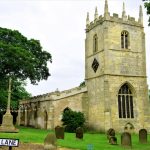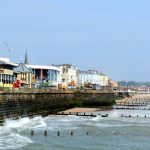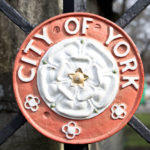Where the Humber Estuary meets the River Hull… There lies Kingston on Hull.
First of all: it’s Kingston on Hull… something nobody that doesn’t live in Hull knows. It is one of the biggest cities along the Humber Estuary. It’s also a University city and has been since 1927. This seemingly sleepy town is more than it seems, with some prominent figures in the abolishment of slavery springing from here, and its own football team, to mention but a couple of attributes.
We took a more in-depth look at Hull, at Kingston, and at Wyke on Hull… which are actually all the same place. So strap in and buckle up for the Five Minutes Spare whirl around Hull.
A Healthy History of Hull
There is evidence that the area of land where Hull now exists has been inhabited for thousands of years – even if the settlement as we now know it didn’t arrive until later. As the Stone Age faded, the earliest farmers set down roots in the valley around the River Hull. It is interesting to imagine what sorts of tools were used, or how long it took for that early people to come together into a community.
Meaux Abbey and the Merry Monks
‘Wyke on Hull’ was founded by a group of monks in the 12th century. It was first recorded as existing in documents circa 1193. It is believed that the monks from Meaux Abbey needed a quay, so they built one, then named it Wyke on Hull. The Abbey itself is mostly ruins today but you can still see some of the earthworks. It was a Cistercian Abbey that was only founded in 1151.
When they were first established the monks owned all of the land around Wyke. It was bought from them in 1293 by King Edward I, a staunch follower of Christianity. Unfortunately, one of his predecessors didn’t have the same regard for the church. In 1539 the Abbey was eventually demolished by King Henry VIII. He used the stones to extend the town of Kingston on Hull. What can we say? He was not a man of the church…
Around 1440 the town had its name changed from Hull on Wyke to King’s Town on Hull. This was later shortened to Kingston on Hull, and the first part was eventually dropped in more recent years. What’s in a name, anyway? There is a lovely little story about how King Edward was overcome when he and a hunting party chased a hare along the banks of the river[i]. They came across the small village of Wyke and fell immediately in love. He reportedly believed that it would be a fortuitous town in future and granted it his own blessing. We can only speculate that it must have been pretty, way back then.
Although we don’t know that much about the early life of Hull, what we can confirm (thanks to Henry VIII) is that many of the stones used to build the oldest parts of Hull are Abbey stones. Although it isn’t known exactly when the town was founded, we do know that it was granted the ability to have both a market and a fair in 1279. The fair would last for days and traders would come from all over England to share their wares.
It is also worth noting that, at this point, Hull was still a town. Kingston upon Hull didn’t achieve city status until 1897. We will talk about why that might be in a moment.
Hull as a Religious Centre
In those early days, Hull was a place of religion. The monastery started this, of course, but It was continued down through the years. In 1285 the Church of the Holy Trinity was built in Kingston Upon Hull. This church still stands to this day, although it was renamed in 2013. You can now attend Hull Minster – like West Minster but for Hull and with fewer MPs.
If you want, or if you are Godly yourself, you can head over to the Minster and make a donation to keep them going. If not, stay with us and read on.
Hull as a Trading Town
The importance of the port in Hull was quickly established in the wars for Scottish Independence. Edward Longshanks needed somewhere to ship men from London up to the northern reaches of his kingdom. Unfortunately for Hull; they were it. Around about the start of the fourteenth century, it changed from sending soldiers out to trading in wool and cloth. Pretty soon the port was the largest in the south-east of England, sending English textiles all around the world.
Hull was part of the Hanseatic League; a community of ports who all worked together in trade. Officially, it was a commercial and defensive group that comprised of tradesmen and guildhalls. Unofficially it was the easiest way we had to trade with towns and ports in the Baltic Sea. Believe us when we tell you that the 1100s was the last time the west traded so freely with Russia. There weren’t any embargoes or sanctions back in those days.
Hull was where the wine came from. One of its main suppliers was Europe, the others included the America’s (although much later, it didn’t exist in the 12th century), Russia… and Scotland. That’s right, first Edward defended against the Wars of Independence, and then he bought all the Scot’s timber. Go figure. France, Spain, and Portugal are all named as some of the places Hull traded with back then.
So as you can imagine; a world where travelling to the next town took two days made Hull a very important port indeed. Without it, most of England would have been dry… and that could have sparked off another war.
Hull as a Carrier
OK, so we know that towns can’t exactly carry a disease – but Hull has seen its fair share of death through the ages. It first started in the 1300’s, not long after the Mint was established. In 1349 the Black Death came to England. This disease could have been cured by a simple antibiotic – but they didn’t exist yet. As such, this coughing, lesion-ridden disease wiped out conservative estimates of one-fifth of the world’s population. One fifth. The equivalent of this devastation nowadays would equal some
Of Europe, the Black Death took between 30 and 60% of the population. It took more than 200 years for the world’s population to recover. This is a large part of the reason why Hull didn’t achieve city status until the nineteenth century. It is thought that the overall effect was to take the population of the known world from 450 million people down to 350-75 million people[ii]. Of course, all estimates are just that. Records, as we know them, didn’t exist back then. Arguably, the churches are the only reason we have any kind of figures at all. Hull was home to the Holy Trinity Church, and so we have fairly accurate information on what happened there.
The Chronicles out of Meaux Abbey tell us that the Abbot at the time (Abbot Hugh) died in 1349 after being head of the Abbey for more than nine years. He did not die alone, either. He was buried alongside five of his monks, who had all died on the same day. An eery account is recorded in the Chronicles, involving an earthquake that was ‘felt throughout England’. This earthquake apparently coincided with a hymn the monks were singing. As they sang “he will strike down the strong” the monks were thrown to the ground. The plague followed shortly after. We take back what we said about the monks being merry… those monks were spooky at best.
Indeed, records of the Bubonic Plague in Hull state that anything from a half to a tenth of the population was all that was left alive after the devastation. While it has been speculated in the past (and even on Wikipedia) that Hull was the port that opened up Britain the plague – this has been proven untrue. The monks of King’s Lynn in Norfolk record that two boats – one from Bristol, the other from France – docked at Melcombe near Dorset. Shortly after the populace began to die off. Thus we can assume that Dorset was where the plague came from in Britain.
The plague returned to devastate the town in 1537, 1575, 1602, 1637 and then in 1832, there was a Cholera outbreak there. In 1881 smallpox killed 689 people, and all of these before the town was even a city. Once America was discovered and Hull started trading with them there was a syphilis outbreak. Hull, although a King’s Town, is a breeding ground for bacteria.
If you want to be scarred for life reading about this horrendous subject then go here. If not, stick with us… we are getting there!
Hull at War
Things went well for a while. After those horrible plague outbreaks, the population slowly re-built. Whenever they did so they became a target. Hull was where past Kings had placed arsenals of weaponry meant to defend the shores. In 1642 the English Civil War broke out. King Charles I and his supporters besieged the town, but their attacks failed. While one side was ordered to secure it, the other was ordered to capture it. The town was held, and the port survived.
Towards the end of the 16th century, the population had grown to 7,500. The Maister House and the theatre were built in the 1700s, and permission to pave, clean, and light the streets came in 1755. 4 years later William Wilberforce was born in Hull. This man helped to abolish the slave trade in Europe and remains a hero to this very day.
Later Life in Hull
A few years after William Wilberforce became an MP in 1780, Hull Royal Infirmary was opened. It was preceded by a much-needed dock, which added to the quay and probably the spread of disease, too.
By the turn of the 19th century, Hull had grown to contain nearly 22,000 souls. The Humber dock was built. Notably, in 1814, the government opened a ‘dispensary’. In these pre-NHS years, the dispensary acted as the only place where the poorest in society could get medicine. Never was such a thing more needed than it was in Hull.
Over the following hundred years, technology had a drastic impact on the town. A dock was built on the Humber, a library was opened, and a power station was built. Street lighting was added, people started getting electricity indoors. Commercially, the town thrived right up until the end of the Second World War… when the population was yet again drained. The textile industry was replaced with the whaling industry, which was replaced with the importation of frozen meats from Australia.
On an economic level, Hull has done very well up until the pre-war years. The Anglo-Icelandic Cod Wars of the 1970s brought a final, conclusive end to Hull’s involvement in harming the ocean. There are still trawlers, but there is a lot more regulation now than there was back then.
WWII in Hull
Before the Second World War, the population of Hull was 239,000. By the end of WWII, the new city had undergone a full 86 air raids[iii]. As a significant port in the south-east of England it became a bullseye target. On a single raid, it is reported that there were more than 200 deaths, another 400[iv]. Times that by 86 and you start to get an idea of how heavily Hull was hit.
It is unclear exactly how many died in these raids… but the Hull Blitz was significant enough to knock down 5,000 houses. Most of those displaced went on to live in prefabricated housing somewhere outside the city and away from their true home. Hull reportedly spent more than a thousand hours under alert. Vague estimates put the death toll around the 1,200 mark. A full 95% of the houses in the city were damaged.
Post War Hull
After the war, the University was opened, and shopping centres became the new ‘trad centres’ over guildhalls. Museums opened left, right, and centre and the Humber Bridge went up. Hull went into a period of depression along with the rest of Britain. The post-industrial economy went into a downturn. This period ended in the ’90s briefly, then the recession hit.
As it currently stands, Hull is suffering just as much as the rest of us are, whether it was once the most important port in England, or not.
Famous People from Hull
There have been a number of famous faces all from Hull over the years. Here are some of our favourites:
- William Wilberforce – Evangelical Christian, MP for Yorkshire, and slave trade abolitionist.
- John Godber – playwright extraordinaire who developed a street style of notoriety in the theatre world. Philip Larkin, another of a similar ilk, also lived here for many years – although he was born in Coventry.
- Fatboy Slim – moved to Hull in the ’90s.
- Trevor Bolder – who you have probably never heard of was David Bowie’s bassist.
You can view the full list here but we caution you that there are more than a hundred…
Some Favoured Hull Attractions
So if you were spending a week or two in the city of Kingston upon Hull, what should you get up to? We have all the hottest tourist attractions, just for you!
Visit the Hull City Tigers
You can visit the Hull City Tigers, the local football club, at KCOM Stadium in West Park. Soccer fans can catch a game on a Saturday afternoon, or even book in on a weekday to take the tour. Only if you are very special will you be invited to watch the lads train… but it never hurts to ask.
The Museum Quarter
Hull is chock-full of museums. The Hull Maritime Museum is by far the most popular, but the Hull and East Riding Museum also has a lot of foot traffic. Arguably one of the busiest attractions in town is the Wilberforce House. This restored museum is the former home to the slave trade abolitionist himself. Someone recorded his campaign trail and housed it here. It is free to enter but please do donate.
Trinity House
The Guild of Trinity House was founded in June 1369 and is associated with the Holy Trinity Church, which is also a major Hull tourist attraction. The guild exists as a trading corporation, built to support the families of the seafaring tradesmen in town. Although now a charity, the house itself is a beautiful site to see. It has been restored in places, but if we were hedging our bets on there being monastery stones anywhere in town it would be here.
The Deep
The deep is not the name of a comedic superhero, but rather happens to be the aquarium and zoo in Hull. This is one of the favoured tourist attractions of Hull according to Trip Advisor, who have it in their second spot. Their first spot belongs to the Streetlife Museum of Transport while their third spot goes to the Humber Bridge.
Historic Old Town
Hulls old town centre has been in play since the 12th century. Albeit severely rebuilt after the WWII bombing, a mixture of merchants housing and shops lies in wait for all who explore it. It runs parallel to the river, throughout the town.
Ferens Art Gallery
If you want to get some culture before you leave then head over to the Ferens Art Gallery. This place is full of exhibitions that will blow you away and routinely changes them, so you always have a good time. If art isn’t to your liking then the Hull New Theatre or Fort Paul are two viable alternatives. The Truck Theatre is also a nice place but it has nothing to do with trucks. Don’t be disappointed.
Interesting Hull Facts
Hull is a fascinating place! Tons of fun, weird, and interesting things have happened here. Here are a few to get you going:
- Hull is the birthplace of the boiled sweet, an invention which went on to loop around the entire world… bet someone wishes they had trademarked that.
- Lemsip was also invented in Hull.
- Amy Johnson was from Hull: the first woman to fly solo from Australia to London. Technically this is a famous person from Hull… but it was so special we added it here, instead.
Where to Eat, Drink, Party, and Stay, in Hull?
If you are going out for Chinese food then ignore the others and head to Noodle Plus, according to Yelp reviews this is the best one. Both Ceruttis and That’s Amore serve lovely food, perfect for entertaining a client or for eating out with the family.
If you want some food with your alcohol check out the Minerva, but the Atom Brewing Co is a solid, 5-star pub. The oldest pub in Hull is called ‘Ye Olde Black Boy’… Seriously. We’re extremely unimpressed that it never thought to change its name.
If you are planning on going to a nightclub then try the Atik or Spiders. If you are staying the night
How to Get There?
How do you get to Hull? It isn’t that hard. Most of the UK just has to head south-east.
By Road
From the south, head north on the A15, or south on the A63.
By Rail
Head north out of London until you get to Hull Station.
By Sea
Hull is a seaport and can be accessed by ferry. You can find information on the ferry terminal here.
Got Five Minutes?
If you have enjoyed our whirl around Hull, then perhaps you will like some of our other articles? You can find out all you ever wanted to know about English towns through our travel section. Not interested? You can always learn a new skill or hobby, instead. When you have a spare five minutes, we have all you need to be entertained. So take your pick and get ready to be amused!
[i] https://en.wikipedia.org/wiki/Kingston_upon_Hull
[ii] https://en.wikipedia.org/wiki/Black_Death
[iii] http://www.hullhistorycentre.org.uk/research/research-guides/ww2-introduction.aspx
[iv] https://en.wikipedia.org/wiki/Hull_Blitz
https://www.hallmarkhotels.co.uk/news-views/8-interesting-facts-about-hull/





